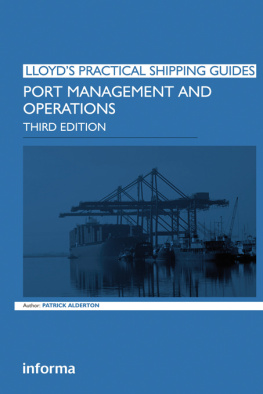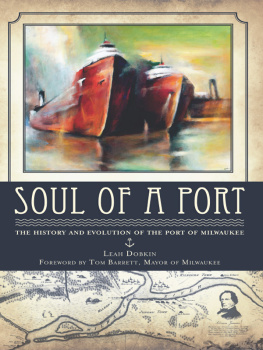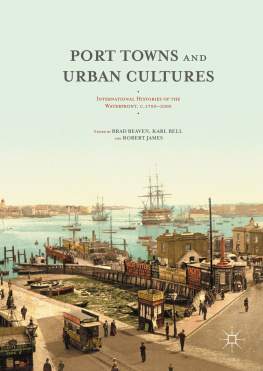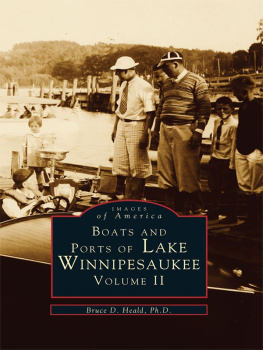Seaports are areas where there are facilities for berthing or anchoring ships and where there is the equipment for the transfer of goods from ship to shore or ship to ship. To use more modern jargon, it is a ship/shore interface or a maritime intermodal interface. From an historical point of view the customs facility is important because without it no international commercial intercourse was legally possible. In many older ports the most imposing piece of architecture on the waterfront is the Custom House.
The major reference books on ports list between 3,500 to 9,000 ports in the world. The reason why the figure varies is that the meaning and definition of a port can vary. At one end of the scale a large estuarial port may contain many terminals which may be listed as separate ports. At the other end of the scale not every place where a small vessel anchors to offload cargo may be listed as a port.
Ports should be considered as one of the most vital aspects of a national transport infrastructure. For most trading nations they are:
- The main transport link with their trading partners and thus a focal point for motorways and railway systems.
- A major economic multiplier for the nations prosperity. Not only is a port a gateway for trade but most ports attract commercial infrastructure in the form of banks, agencies, etc., as well as industrial activity.
Ports should also be considered as one of the most important aspects of maritime transport because they are the location:
- Where most maritime accidents happen. This is inevitable, as it is a focal point, usually in shallow water, where ships converge.
- Where cargo is damaged or stolen . Again this is inevitable as a port is a place where the cargo is handled and a place where valuables are concentrated. One of the initial reasons for building enclosed docks at the beginning of the last century was to reduce theft. However, with full container loads reducing handling in port and the increasing speed of throughput the significance of this element should be reducing.
- Where repairs are carried out . Although a port is obviously the only place where many repairs can be attempted the more modern practice of planned maintenance means that shipowners can plan at which port the repairs or maintenance will be done.
- Where most costs are incurred . Although some of these costs and delays form part of the essential and inevitable activities of a port, others, such as documentary costs and delays, are simply part of an historical tradition which could and should be changed.
- Where delays are most likely to occur.
- Where surveys take place.
- Where most shipping services are located, e.g. agents, brokers, etc. This still seems to be the case in spite of modern communication systems.
- Where industries are situated. This has greatly accelerated since the Second World War.
- Where cargoes come from.
- Where customs and government policies are implemented.
Dr Ernst Frankel, in his book Port Planning and Development (1986), estimates that only 4045% of all transport costs in international trade are payable for productive transportation. For general cargo the figure is probably only 33%. Much of the extra cost and delay occurs in ports (but is not necessarily caused by ports). As indicated, ports are places where numerous controls are imposed, such as documentary controls, finance controls, import controls, etc. For obvious reasons ports have developed as areas of storage while cargo waits for distribution, further processing or onward movement.
In Japan where there are officially classified 1,100 ports and harbours (21 of which are rated as major ports for international trading) the multiple role of a port is well recognised as a:
- Distribution centre.
- Industrial zone and energy supply base.
- Mercantile trading centreattracting banks, brokers and traders.
- Urbanisation and city redevelopment centre.
- Life activity basethis is particularly the case for the smaller rural ports.
- Maritime leisure baseyacht marinas, dockside recreation facilities, cruise ship terminal.
Note of the 21 ports rated as major ports in Japan, Yokohama, Tokyo, Kobe, Nagoya and Osaka handle the greater percentage of foreign containerised trade. Kobe was number 6 in the world league of container ports before the great Hanshin earthquake in the early 1990s reduced its position seriously. However, by 1997 it had recovered 80% of its previous container throughput and by 2002 was rated number around 24 in the container traffic league. This is a good example of the effect of a natural catastrophe on a port and the ability of good management to overcome such disaster.
- Ports tend to be large civil engineering undertakings with huge sunk costs. They also tend to last much longer than the vehicles that use them. If a shipowner makes a mistake in the type or size of ship he buys he can usually recoup his losses by selling his mistake. A port manager will usually find it more difficult and costly to dispose of his mistakes.
- A ship is an entity, whereas a port is simply a collection of activities. This makes it more difficult to talk about ports in general. A small ship has many technical and operational features in common with a large ship but it is sometimes difficult to see what a small fishing port in a developing country has in common with, say, Rotterdam.










